An exciting movement is rippling across the country and it has taken hold here in Nevada. Little Free Libraries are being built and championed by community members, local groups and politicians. A Little Free Library (LFL) enacts the “Take a Book, Leave a Book” philosophy. LFLs are small, custom-built freestanding boxes that house anywhere from 20 to 100 books. LFLs are often uniquely designed (typically very cute) and can be made of any material able to withstand the outdoor elements. Finding a suitable location for the LFL is an important decision. The location for an LFL should be well planned and easily accessible, allowing community members and passers-by the opportunity to stop, browse and take or leave a book.
Although the LFL idea started in 2009 with Ted Bol, a resident of Wisconsin who wanted to honor his mother’s love for reading, it has since grown into an international movement whose mission is:
“To promote literacy and the love of reading by building free book exchanges worldwide and to build a sense of community as we share skills, creativity and wisdom across generations.”
LFLs have become far more than a simple book exchange. As of September 2015, over 32,000 LFLs have become officially registered. LFLs are in 50 states and in over 70 countries worldwide (Little Free Library, accessed 23 September 2015).
Peter Burge 2015
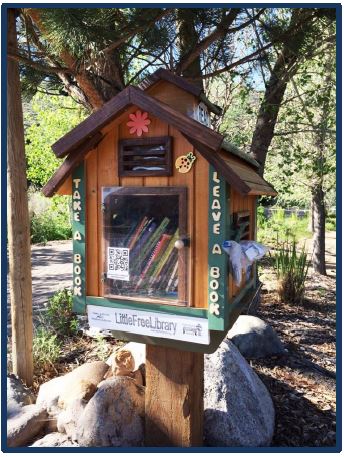
1 Community Development Specialist, University of Nevada Cooperative Extension
2 Little Free Library Champion and UNR Graduate Student
3 Little Free Library Champion
4 Extension Educator, University of Nevada Cooperative Extension, Churchill County
We’ve always had free book exchanges. What’s so different about these LFLs?
First of all, LFLs are cute! One could even describe an LFL as an artistically designed little house of books. LFLs have also become an effective way to build a sense of community, promote community pride and encourage literacy within communities. Because LFLs are physically placed in a neighborhood and accessible for anyone, they provide a public space for residents to stop, browse books and perhaps engage in conversation with each other. In addition, because each LFL is unique (both in library design and the books themselves), LFLs help create a sense of community pride and encourage neighborhood interaction.
…And don’t forget the Books!
LFLs promote the love of reading and encourage literacy. Literacy is an important issue in Nevada. Nevada is ranked 43rd in the nation for elementary reading proficiency (Nations Report Card, 2013), and research indicates a direct relationship between third-grade reading level proficiency and high school graduation (Annie E. Casey Foundation, 2013). Unfortunately, Nevada has a high school graduation rate of 63 percent, one of the lowest in the nation (Nevada Education Data Book, 2015). Although an LFL will not singlehandedly change the statistics on grade reading level in Nevada, it can put a book in the hands of a child who lacks access to books. It may also foster friendly neighborhood conversations.
OK, I’m interested in a Little Free Library. How do I get started?
There are a few important roles and responsibilities involved in getting a Little Free Library in your neighborhood. To help get you started, we compiled a checklist that summarizes our experience in helping to expand Little Free Libraries across Nevada.
Steward
The first step is to decide if you want to serve as a steward or do you need to find a steward? A LFL steward has several important responsibilities. The steward is the person who is officially responsible for the care, maintenance, upkeep and management of the LFL. One of the biggest tasks of being a steward is finding or securing the location.
Location
As a steward, you are responsible for ensuring that the location selected is both well suited for an LFL and is also legally permissible. Will the LFL be placed on private or public property? If the LFL is placed on private property, is this on your property? Do you need to get approval from the Homeowners Association? You may need to review the Code, Covenants and Restrictions (CC&Rs) for the neighborhood.
If the LFL will be placed on public property, do you need to review zoning laws or seek approval before the City Council or County Commission? To determine zoning ordinances within Washoe County, you may call them directly at 775-328-6100 to inquire about possible zoning restrictions in the County. If the LFL location is within the City of Reno, call Code Enforcement at 775-321-8309 directly. Code Enforcement can review the address and provide details on what is allowable regarding zoning ordinances for the City of Reno. If you live outside of Washoe County, please make sure to contact you local zoning department. Most rural counties in Nevada do have planning departments; however you will want to confirm with your local county or city departments to ensure your LFL location is permissible.
Aside from determining zoning ordinances and CC&Rs, an ideal location for your LFL is one that receives foot or bike traffic, such as along a walking path or bike path, or on a cul-de-sac in your neighborhood. The purpose of an LFL is to share books with community members and allow community members to stop, browse and look, in a safe and welcoming space.
Stewards are also responsible for maintaining the LFL. This includes ensuring appropriate books are stocked, especially if children are accessing the LFL. In the unfortunate event of vandalism, a steward also agrees to take responsibility to repair the LFL to ensure community pride. In this sense, a steward is both a steward of the LFL and an ambassador for the community.
Marlene Rebori 2015
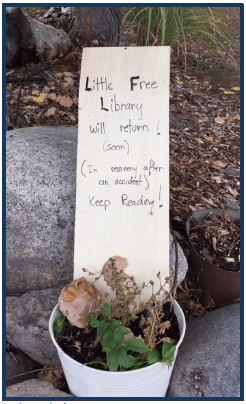
Builder
In Nevada we have approached the building of LFLs in a variety of ways. Some people build their own LFLs, or if you are someone who lacks building skills, an LFL can be purchased directly from the LFL organization (http://littlefreelibrary.org/product-category/library/). However, the cost to purchase an LFL from the LFL organization can range anywhere from $150 to $1,500 (Ouch!), hence purchasing an LFL can be cost prohibitive for many communities.
A great strategy to get your LFL put together and, one that also fosters a sense of community, is to collaborate and partner with local businesses, contractors or public educational institutions. Little Free Libraries make wonderful community service projects for Boy Scouts, Girl Scouts or student clubs. Another idea is to leverage and network among existing community resources. Is there a neighbor you can ask to help build an LFL? Have you thought about asking for donations from a nearby lumberyard or asking for scrap material left from a recent project? Many of the recent LFLs in Reno were actually built with scrap supplies by contractors who donated their time and skill to help enhance our community. If you’re looking for some design ideas, you can contact Truckee Meadows Community College (TMCC) drafting department. TMCC students have created various LFL designs for a class project.
Nevadans are good at networking, and we know that healthy communities are communities that are able to civically engage. To engage civically means community members have the skills to come together, talk and collaborate on public projects, thereby building and strengthening our community relationships (Levine 2013). Communities that have strong civic relationships increase their ability to address larger public problems and create their community of choice (Matthews 2014). While you work on building a Little Free Library, you are also building your community connections and networks.
Supplier
A LFL needs to be supplied with books. As a free-book exchange, an LFL is about “take a book, leave a book.” However, sometimes more books may be leaving the LFL than coming in. The steward needs to monitor the books that are being placed in the LFL, as well as ensure it is stocked with appropriate books for the neighborhood.
Grassroots Books in Reno has been a wonderful supporter of LFLs and often has bag sales of books from their warehouse from which you can quickly, easily and inexpensively restock books for your LFL. Another idea is to coordinate a neighborhood book drive. Fellow neighbors or nearby local businesses could help serve as a collection area for residents, providing a box for books until the steward collects them to restock the LFL.
Peter Burge 2015
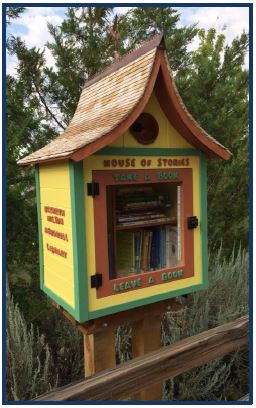
Installer
The design of your LFL will also determine how it is installed. The LFL website has recommendations for installation, including mounting suggestions and ground depth for post installation. However, in Nevada’s dry, rocky soil, installation of the LFL can be challenging. We have used two different types of installation in Nevada.
Ground Install
The LFL can be mounted to an upright post secured in the ground using two pairs of steel gauge brackets (16-inch or 12-inch gauge). Brackets are mounted to a wood post with four steel screws. Each bracket, used in pairs, are mounted to a 4-inch by 4-inch wood post with four 1 ½-inch long by ¼-inch thick steel screws. The library boxes, made of ¾-inch plywood, are bolted to the brackets with the steel screws. Make sure the posthole is dug at least 2 feet deep and secured with concrete. In rural communities it may be possible to ask your local public works office to dig the hole with an auger and secure the post with concrete. Ensure the post is secure in the ground before the LFL is mounted to the post.
Container Install
If you feel your location may move, or it simply is too difficult to dig a post into the ground, one steward in Nevada built wooden containers. These wooden containers serve a similar need as a portable stand. The container needs to be large enough to hold and secure a wooden post. Fill the container with concrete or rocks and sand. Mount the steel brackets to the post, which is secured inside the container, and ensure the LFL is not top-heavy.
This sounds exciting. Is there a support network?
We have established an informal support network, the Great Basin Little Free Library Circle to share stories and ideas and to expand LFLs across Nevada Communities. You can join the Circle and see what’s going on in your neighborhood and across the state.
Register
…Don’t forget to officially register your Little Free Library!
Last but certainly not least, don’t forget to register your LFL. For a little over $40 you can officially register your LFL, receive a Steward Handbook and get on the World Map of LFLs. In the spring of 2015, Nevada had the least amount of LFLs officially registered (four). This has quickly changed, as of October 2015, Nevada has 29 LFLS officially registered, and the list keeps growing.
With a little bit of planning, neighborhood conversations and community collaboration, anyone can steward a LFL in their neighborhood. The process of planning a LFL can be a fun and meaningful project that helps promote community pride, encourage literacy and bring neighbors together.
Who knew such a little box of books could have such a big impact?
Peter Burge 2015
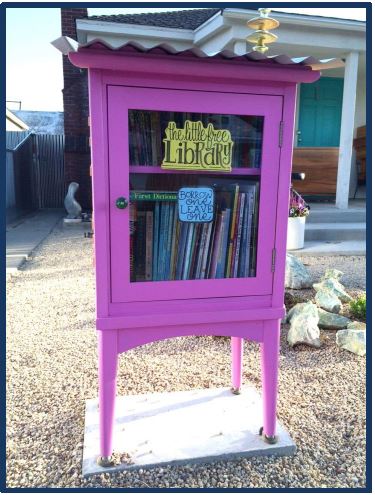
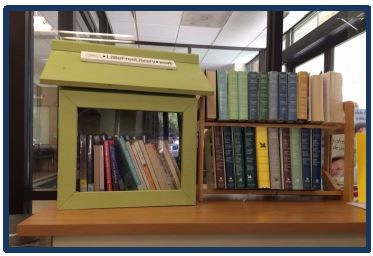
References
- Nation’s Report Card. (2013). U.S. Department of Education, Institute of Education Sciences, National Center for Education Statistics, National Assessment of Educational Progress (NAEP), Mathematics and Reading Assessments.
- Nevada Education Data Book (2015). Nevada Legislative Counsel Bureau.
- Annie E. Casey Foundation (2013). Early Warning Confirmed: A Research Update on Third Grade Reading. Annie E. Casey Foundation, Baltimore, MD.
- Levine, P. 2013. We Are The Ones We Have Been Waiting For: The Promise of Civic Renewal in America. Oxford University Press. New York, NY.
- Svara, James and Denhardt, Janet (2010). Citizen Engagement, Why and How? in “The Connected Community: Local Governments as Partners in Citizen Engagement and Community Building.”, Arizona State University, Alliance for Innovation. NLC (Accessed 2 October 2015).
- Matthews, David. (2014). The Ecology of Democracy: Finding Ways to Have a Stronger Hand in Shaping Our Future. Kettering Foundation Press. Dayton, Ohio.
Bender, P., Burge, P., Powell, P., and Rebori M.
2015,
Little Free Libraries in Nevada: What, Why and How,
University of Nevada Cooperative Extension, Fact Sheet-15-09


